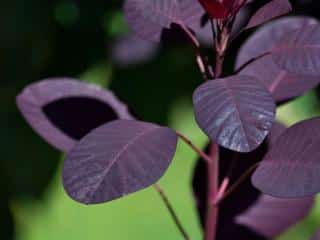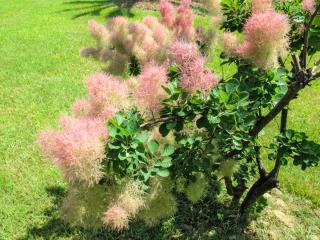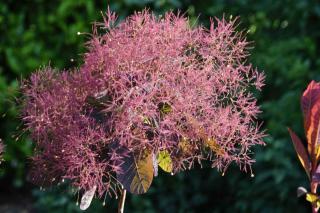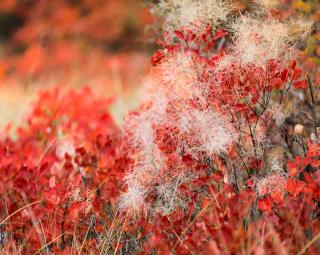

Cotinus tree blooms bring a surprising touch of hazy light and volume to your garden.
Cotinus key facts :
Name: Cotinus sp.
Family: Anacardiaceae
Type: tall shrub or short tree
Height: 10 to 13 feet (3 to 4 m)
Breadth: 6 to 10 feet (2 to 3 meters)
Exposure: full sun
Soil: any type, as long as well drained
Hardiness: -4°F/-20°C – Grows: fast – Leaves: deciduous – Flowering: summer
Excellent planted as a standalone, in a shrub bed and as a mixed hedge shrub.
Common: smoke tree, smokebush
The entire botanical genus for Cotinus stands out for more than one reason. Its leaves, first and foremost, have an unusual oval shape, and their color changes dramatically as seasons come and go, each species in its own way. You can thus choose between green and deep purple in spring, which then shifts to yellow-orange as fall comes near.
Flowers, secondly, are astounding: they’re clustered in bright silky plumes that are light pink to deep purple in color.

The rather large size it reaches hint at its preferred planting situation: directly in the ground in the garden. Nonetheless, since it also copes well with severe pruning, it’s also possible to plant it in a pot.
 Dig a planting hole that’s more on the large and deep side.
Dig a planting hole that’s more on the large and deep side. Get your hands on a voluminous pot and check for presence of drainage holes.
Get your hands on a voluminous pot and check for presence of drainage holes.During the first few years of growing, pay attention to watering, especially during droughts. When it has properly settled in, the shrub can cope with lack of water on its own.

You must prune at the end of winter. Smokebush blooms on new growth, so fresh shoots will be loaded with flowers in summer. Also remove dead branches and those that always get in your way.
If your Cotinus gets too large for your garden, it helps to know that you can cut it back hard.
→ Note: it’s part of the same family as poison ivy, so if you’re sensitive to that, wear gloves when handling sappy branches (risk of light dermatitis).
To get new smoke tree specimens, simply prepare cuttings from semi-hardened wood, or layer it.
Very resistant, your Cotinus isn’t vulnerable to many diseases. If weakened by drought or overwatering, it might get infected by verticilium wilt, leaf spot, and rust. It also doesn’t seem to attract parasites and pests.
This variety is particularly interesting, especially thanks to its purple-leaved cultivars such as the ‘Rubrifolius’ (deep purple with silvery overtones) and ‘Grace’ (light purple). The most famous is Cotinus coggygria ‘Royal Purple’ which has red-rimmed leaves.
Similar enough to its cousin C. coggygria, C. obovatus is different in that it grows taller: it reaches heights of 30 feet (10 m).

Have fun pairing it with other purple-colored plants, creating a beautiful camaieu in your garden with Physocarpus opulifolius ‘Diabolo’ and Berberis thunbergii ‘Atropurpurea’ or ‘Harlequin’.
If you’d like to try alternating deciduous and evergreen foliage shrubs, Photinia, privet, Escallonia and Silverberry are great candidates.